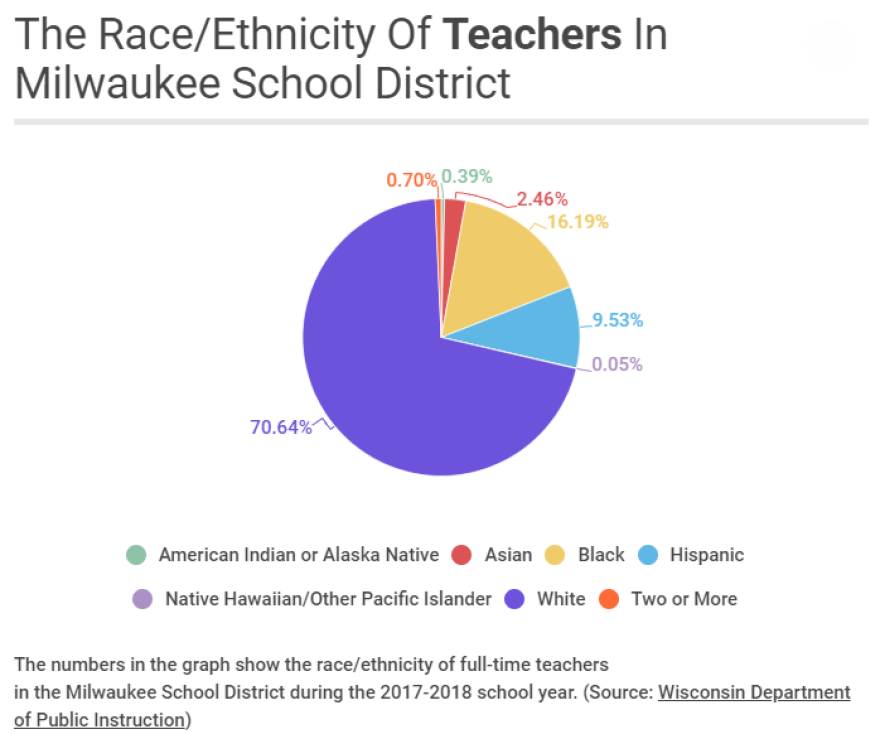How important is it for a student to be taught by a teacher of the same race? That's something that's been on the mind of community member Ann Stanton, so she submitted a question to Beats Me — our series that allows you to ask questions about race, education, innovation and the environment.
“What is the ratio of black students to white teachers, and the black teacher makeup in MPS? What impact does that have on student achievement?”
Beats Me: What Questions Do You Have For WUWM's Beat Reporters?
To begin investigating Ann's questions, I visited some Milwaukee Public Schools to see what local classrooms look like and to speak with students and teachers.
In The Classroom
My first stop was Dr. Martin Luther King, Jr. Elementary School, an African-American Immersion school on Milwaukee’s north side.
Kindergarten teacher Angela Harris, a black woman, says she has strong feelings about students seeing representation in their instructors.

“I believe wholeheartedly that when you put people who look like you in front of you, it opens up a different outlook for yourself,” she says.
Harris pursued a career in education with that in mind. And as a Milwaukee-native, she says teaching in a Milwaukee school, specifically in a kindergarten class, was always important to her.
“Having the opportunity to stand in front of students who look just like me and say: 'This is something that you could potentially do with your life. You don’t necessarily have to be a basketball player or a rapper. You can be a teacher, you can be a principal, you can be an administrator at a school. These are all actually goals for yourself and there’s so many people here who look just like you who have done this and who are successful at it,'” she explains.
Harris also commented on the connections she still has with students who have graduated from her class. Some of them, who are now second graders, eagerly rushed to hug her as she walked down the hall.
All of Harris’ kindergarten students were black. But what about the demographics of teachers and students across Milwaukee Public Schools?
Breaking It Down
According to the Department of Instruction, 52 percent of students were black in the Milwaukee School District during the 2017-2018 school year.

While more than half the students were black, only 16 percent of teachers were black — 70 percent of the teachers were white — in the Milwaukee School District during the 2017-2018 school year.

Researchers have often examined the long and short-term effects of students of color having teachers that look like them. Constance A. Lindsay, a research associate at the Urban Institute, says it does matter.
She says a study conducted in 2004 by Thomas S. Dee found that students from disadvantaged groups score higher on standardized tests when randomly assigned to same race teachers. And studies that followed found similar results, Lindsay adds. For example, she was one of a four-person team that explored the link between having the same race teacher early in life and looking at later life outcomes.
“If you have the experience of having one black teacher in elementary school, particularly for low-income black boys, you are less likely to drop out of high school and more likely to say that you are going to attend college,” Lindsay says based on the study's results.
The study found that having one black teacher in third through fifth grades decreased a black student’s probability of dropping out of school by 29 percent. The impact was even greater for black boys in low-income families — their probability of dropping out of school was reduced by 39 percent if they had a black teacher in third through fifth grades.
What Students Think
So, do students think it's important to have teachers of the same race? I headed to the Barack Obama School of Career and Technical Education, which is also on the city’s north side, to find out.
Angel Engel, a junior, says, "I've had a lot of white teachers that did similar things, like motivate me and tell me to do better, but when it's coming from somebody that looks like you, you can just relate more."
Carlesha Done, a senior, adds, "It's like a better connection because you can see where they're coming from."
Another student, Franchon Avant who's a junior, says African-American teachers also realize that many of their students may need a good support system "because [teachers] might know what it's like not to have had one when they were growing up."

All three students agree that a teacher’s race shouldn’t matter when it comes to connecting with every one of their students.
While there are programs in Milwaukee to help teachers from all backgrounds incorporate culturally relevant curriculum to connect with their students, some efforts are underway to put more teachers of color in the classroom.
Support for Race & Ethnicity reporting is provided by the Dohmen Company.

Do you have a question about race in Milwaukee that you'd like WUWM's Teran Powell to explore? Submit it below.
_






